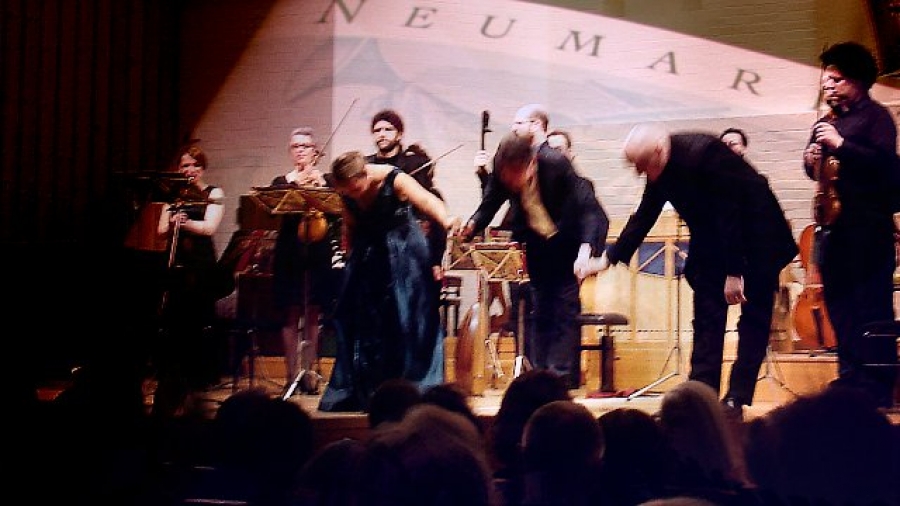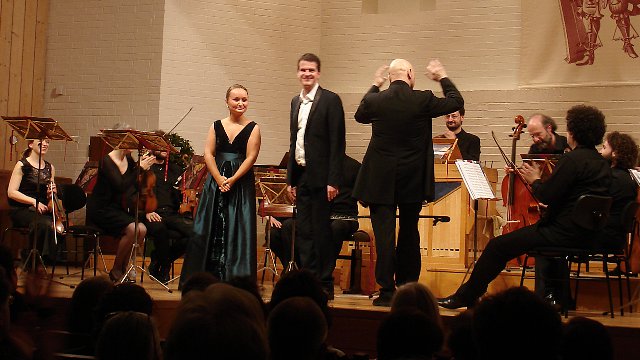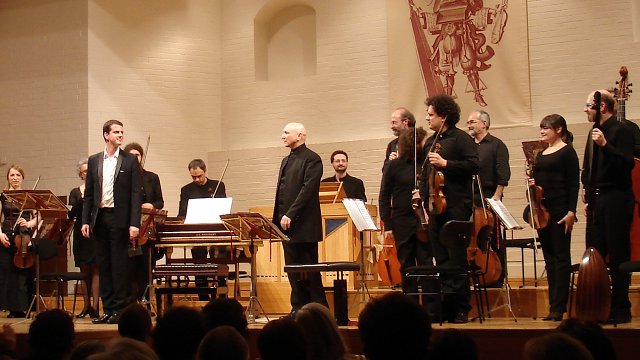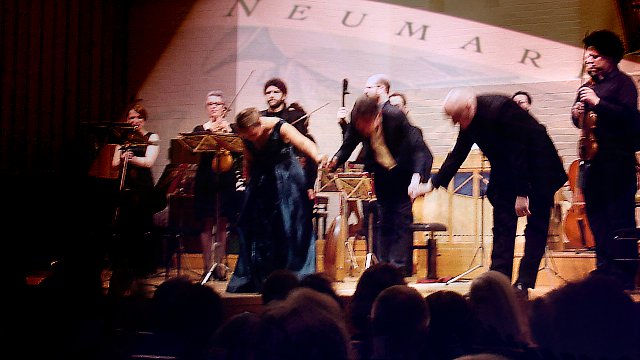– by Lankin –
The Concert Hall
The Reitstadel in Neumarkt is famous for its acoustics and is frequently used for recording. It is a box-shaped room with a balcony at the back, with seating space for a total of around 500 people, but a good many were standing that night, so there were more.
The audience in Neumarkt is very disciplined and cultivated. Ansbach — where the famous Bachwoche takes place — is not far from there, and the concert at the Reitstadel that night had most of the same clientèle — a mixed audience in every respect, and they knew what to expect — even if, of course, not all of them had heard Jaroussky or Lezhneva perform live before.
No one clapped their hands or made a noise between the movements, no coughs, no ticking watches – heaven, basically.
The Musicians
Philippe Jaroussky doesn’t need any introduction here; maybe Julia Lezhneva does: She is very young indeed, and Wikipedia seems unsure how to classify her voice — maybe because it is truly one of a kind — round, warm, very flexible, and first of all, huge. She studied with Elena Obraztsova, and this influence is clearly apparent. If she would set her mind to it, she could surely sing Elsa or Senta. Her voice is beautiful throughout, perfectly blending through the registers, and of course, she is a great musician.
Considering her huge voice it was rather surprising for me that Jaroussky’s easily matched hers. This is especially notable, as the Stabat Mater is quite low for him.
The two voices blended and mixed perfectly almost the entire time. In my estimate, Jaroussky more tried to match her phrasing and tone of voice than vice versa though, so, I saw this mainly as his achievement. Of course, he is a very routined and great duet partner.
I Barocchisti under the baton of Diego Fasolis were great, even if everyone might have their favourites among the ensembles. Fasoli’s tempi weren’t so daring as Jérémie Rhorer’s were, and he is not someone who loves effect as much as Spinosi does. His conducting had some splendid moments though. Memorable for me were especially the Cuius animam gementem and the Pro peccatis suae gentis where he really managed to add an edge to the piercing sword and the lashes of the scourge, and what may have been even more notable is his wise choice of tempi, always putting the singers at ease. That might be less evident, but the greater achievement overall.
The Music
The programme started with one of Händel’s most famous Violin concertos, HWV 399 op. 5 Nr. 4. Especially the last movement, a Minuetto, is quite popular. It was a nice and secular start, abducting the audience from their everyday life, and making them truly arrive there — body, heart, soul and ears — thus serving as an overture. The concerto matched smoothly Händel’s Salve Regina (g-minor, HWV 241) that followed.
Lezhneva made quite an impression, despite her youth singing with admirable routine and expressiveness. As I said before, her voice is round and warm, darker than that of a typical lyric soprano. The only thing I found a pity is that while in the Salve Regina she could flaunt her coloratura skills, her lyric lines, and her wonderful pianissimi, the piece gave her little opportunity to use all of her voice — the Cuius animam gementem later on made me crave to hear her voice in something not Baroque. We will, though — I am confident she has a great career ahead of her.
After Lezhneva’s entrance, it finally was Philippe Jaroussky’s turn, with the Vivaldi Cantata Longe mala umbrae terrores.
It was a contrast in every way. Jaroussky’s voice so unlike Lezhneva’s, Vivaldi’s expressiveness so unlike Händel’s Salve Regina. Where the Salve Regina is moderate, the Longe male is almost violent in its description of the vale of tears that is life. I long to have this piece on CD, but then, I have a good memory for music — I will never forget his performance of that night.
Jaroussky and Fasolis, regarding each other with mutual respect.
Whereas the start of the programme comprised of not so popular works, the Stabat Mater is of course one of the most famous compositions by Pergolesi, and one of the church pieces performed most often even, I would guess.
Pergolesi’s Stabat Mater
Be it Pergolesi, or Mozart; their early death somehow makes their works even more precious. Mozart’s last work was the Requiem, of course, which stayed unfinished — he stopped composing right in the middle of the ascending line “solvet saeclum in favilla.” Pergolesi’s last work was the Stabat Mater; he did finish it. The end of the Stabat Mater, the Quando corpus morietur, followed by the obligatory Amen were the last things on his mind as a musician. He didn’t just write it out of a sense of duty, fulfilling a contract — it is personal. He was dying when he wrote it — slowly, and probably painfully, as dying of tuberculosis isn’t a quick and clean death.
“When my body will die, make that my soul is given the glory of paradise,” the text ot the Quando corpus morietur states. There is no true hope of salvation, though, but instead an endless strife, disheartened by many attempts set into music by the deceptive cadences.
When I listen to the very last bars of the Quando Corpus, I notice a similarity to Mozart’s Lacrymosa. Both have a similar motif in the strings, a rest on the first beat of the bar, with the plaintive motif afterwards. I wonder if Mozart thought of Pergolesi’s piece, or if he by chance picked a very similar phrasing. Both stay in minor, and both pieces have a more than humble approach; it doesn’t need much imagination to picture soldiers returning from battles, defeated, or delinquents heading for their execution.
There is no host of angels like in Bach’s final chorus of the St. John’s passion, lifting the dying — and thus, the listener — up with them, soaring and triumphant — there is only little comfort, but much pain, no true final salvation. The little motif of the violins might be heard as plaintive like a sob, or like a soft and futile caress, like a mother would caress her child that is dying in her arms nonetheless. Both pieces — Mozart’s and Pergolesi’s — are almost painful in their intensity.
So this is the Quando Corpus Morietur for me. That night, though, there was more to it. To explain, I would have to mention an interview that Mr. Jaroussky gave once.
Comment aimeriez-vous mourir ?
— Sans m’en rendre compte.
Si vous êtes croyant, qu’aimeriez-vous que Dieu vous dise en arrivant au ciel ?
— Je ne crois pas, du moins pas en Dieu.
I had to think of those words incessantly, during the whole concert. They moved me, since I first heard them. To imagine a world without Philippe Jaroussky in it hurts me more than to think of my own death, by far. That art and recordings live on is only a feeble comfort; it is not even remotely the same as a living, breathing person.
But maybe I am wrong; Pergolesi lives on as well — his anguish when he was dying, but also his wit and charm in La Serva Padrona.
The combination of Philippe Jaroussky and the most heartbreaking piece of Pergolesi’s was a hard combination to bear for me that night. I tried to listen more analytically, to look more at Ms. Lezhneva than at him, or close my eyes when he was singing to be able to handle my emotions in dignity.
There were standing ovations and cheers for Lezhneva, Jaroussky, and I Barocchisti with Mr. Fasolis.
As an encore they chose — the Quando corpus morietur! So, we all died twice that night.
We had the honour to meet Mr. PJ afterwards, and there would have been so much more I would have wanted to tell him than the chitter-chatter I molested him with.
But then, it would be of no avail, just like the Quando corpus moriertur. What is there to add? Mortality is a dire thing.
Just, don’t die — live forever!





Thank you so much for your detailed report and very enlightening one indeed of the concert at Neumarkt. I wish I was able to be there but with your report, comments I was able to grasp the atomosphere, the greatness of the concert. I was there 2010 so I
remember how the town, Reistadel and the audience were. I had a report that PhJ was so tired out fro the recording session prior to the concert(I suppose the recording of Stabat Mater?) that he had bit of hard time in the beginning. I suppose in Longe mara…?
I am happy that he recovered quickly after that. Thanks again for your wonderful report.
Hope you are going to Metz for Caravaggio?
Are you sure with ” Mr. Fagioli “?
Haha! Thank you for pointing it out, this is really embarrassing. I named him correctly at the beginning, so… *scratching head.* What is there to say in my defence — I am bad at names? It was 2 at night? But none of these points is of course Mr. FASOLIS’ fault. So, let me humbly apologize, and thanks again for telling me!
Oh and, I have been told this post was linked to — it was, and…
Now this was reason three, also not Mr. Fasolis’ fault, but now I know why I mixed him up.
Hmmm, and concerning the roses… According to this page I found…
http://www.proflowers.com/flowerguide/rosemeanings/
More or less…
Of course, there are many other meanings, and there are regional differences; flowers have some hidden language that is taken less serious nowadays overall. There are exceptions, though, like white lilies, and other flowers, which are strongly associated with specific occasions. Lilies here are reserved for funerals, but they also carry a very sexual meaning because of their lascivious smell. This combines in them being traditional, or so I’ve heard, for the occasion when a girl becomes the “Bride of Christ” as well. (Can someone confirm or contradict this? I’d be curious.)
But then, it is like with any language; it is hard to have a conversation if the other doesn’t understand a word you are saying.
For a divorce, I would suggest, e.g.:
Thanks for your comment! He had, but only at the very start, I didn’t have the impression he was vocally exhausted in any way though.
The “Longe mala …” starts very dramatically, and his voice cracked a little at one point — I found it very pardonable, as expression comes first thing at the start; it could as well be spoken. The text is:
“Longe mala, umbrae, terrores,
Sors amara, iniqua sors.
Bella, plagae, irae, forores,
Tela et arma, aeterna mors.”
“Be gone, pain, shadows, horrors,
Bitter fate, unjust destiny.
War, pestillence, rage and fury,
Weapons and armour, eternal death.”
So, for me, sheer beauty of voice is not what is primarily called for at the very beginning.
I found a recording on YouTube where Laura Polverelli sings it, just to give an impression, for those who don’t know the piece — it is great.
[youtube TSiQ9JdSbec]
As far as I remember, his voice cracking a little was at the very first … “terrores, umbrae, terrores …”
Why I didn’t write it, even forgot to mention — for me it adds to his charm, and might even be an essential part of it; there are quite a few recordings of his where one note or the other isn’t “perfect”, a “tigre sdegnosa, …” here or the first bars of a “Venti turbini,” once.
Why I still appreciate those tiny flaws in singers, and highly, is complicated. I do not long to see them fail, it does’t give me a kick, but I cannot say it doesn’t matter to me either; it matters, I feel a surge of empathy for the singer, thinking *darn,” and moving on with my attention.
What attracts me is not the flaw as such, but the way of singing that leads to it. It is not a lack of technique, let me stress this.
Basically, I think it is very brave to sing that way, especially the opening bars. It would be easier to play it safe there if it is live — in a recording session it wouldn’t matter anyhow, you just give it another take.
Maybe brave is not even the right word; for me it is the price of a certain way to handle the voice, to sing very freely. I wouldn’t want to miss this for the price of an outward perfection at all times. There’s no freedom without the potential for failiure. So, it is more than just a way to sing; it is connected to a certain personality.
I feel the same way when I listen to Moffo’s almost vulgar sobs at her “Sempre libera” or one of Callas’ last renditions of “Pleurez mes yeux” where her voice literally breaks at the last notes.
[youtube mz63zMbVSQw]
(This is not the recording I meant, my favourite is from a 3 CD box set, but the end is similar — not strictly perfect, even though perfect in expression.)
Oh, and Metz! I won’t be able to manage because of several reasons; I hope there will be a DVD or a recording though. I hope you’ll have a great time — and do write a review!